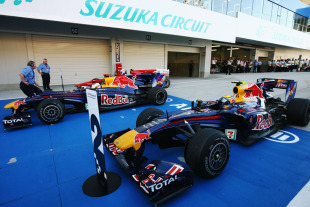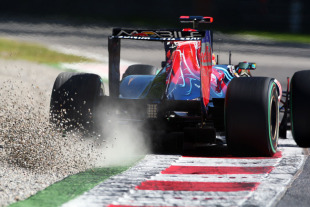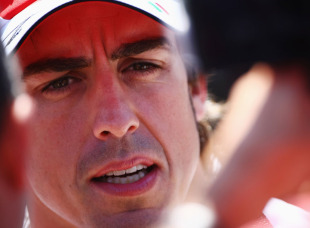- 2010 F1 business review
Red Bull wins the money championship

- Feature:
-
Counting the cost of F1
- Feature:
-
Ferrari's forty-million dollar man
- Teams:
- Alfa Romeo
- |
- Ferrari
- |
- HRT
- |
- McLaren
- |
- Mercedes
- |
- Racing Point
- |
- Red Bull
- |
- Renault
- |
- Team Lotus
- |
- Toro Rosso
- |
- Virgin
- |
- Williams
The 2010 F1 season was seen by many fans as the most exciting in years, but although the battle on track caught most of the attention, the crucial off-track battle to emerge top in the financial stakes was full of plenty of twists and turns of its own.
Red Bull emerged triumphant off the track as well as on it and ended the season with more than just two championships to celebrate. Although the energy drinks giant poured an estimated US$240m into Red Bull Racing and Toro Rosso throughout the season, it got much more than its money's worth in return.
The key to how it achieved this is the main reason that many sponsors and team owners take part in the sport: brand exposure. More than 520 million people globally watch F1 every year and companies are willing to pay big money for access to these viewers, just as they might otherwise pay to advertise during a TV broadcast's commercial breaks.
After each race, Formula Money's ROI Review calculates the value of the time spent on screen by every brand, as if it had been purchased as global TV advertising slots. Unlike traditional TV advertising which provides a defined slot with a tailored message, showcasing a brand in F1 is a tricky business. Each sponsor shares the screen time with over a hundred other companies and there is no guarantee when and for how long its brand will appear.
Formula Money estimates that during 2010 the Red Bull brand gained exposure which would have been worth a huge $358.5m if it had bought it as traditional TV advertising. This represents a 150% return on its spending, demonstrating why F1 is such an important platform for the Red Bull brand around the world.

Remarkably, Red Bull took a massive 30.5% of the exposure of all F1 brands in 2010. This was down to having its brand displayed prominently on two teams, which would have given it a major advantage even if it hadn't won the title. All the same, its strong performance on track was certainly a big factor in this. More than $255.2m worth of Red Bull's exposure was generated through its logos on Red Bull Racing, around 70% of the total. The faster the car, the more exposure it will get during the race, which is the key reason why the better teams draw more sponsorship investment.
To top off Red Bull's amazing year, exposure of the company's brands doesn't stop with its signature beverage. Branding for Red Bull Mobile generated exposure estimated to be worth $4.3m in the equivalent advertising value, with Red Bull Cola and Scuderia Toro Rosso decals generating exposure worth $2.1m and $1.7m respectively. This brings the total exposure value for all Red Bull's brands to $366.6m, placing it streets ahead of its rivals.
All together, the 141 brands with on-car logos in Formula One in 2010 gained exposure worth $1.2bn, an average of $62m per grand prix. This included not just sponsors and team owners, but the engine manufacturers, the team names themselves and charities, such as the FIA's Make Roads Safe campaign which appeared free-of-charge on all the teams' cars throughout the year. The campaign got coverage from this which would have cost it $1.3m if it had bought the time as standard TV advertising.
The closest challenger to Red Bull's supremacy was McLaren's title sponsor Vodafone, which drew exposure worth $122.5m throughout the year, giving the mobile phone provider a return of almost 190% on the $65m it spends annually. It was followed by Ferrari's major new partner Santander, which got exposure worth $99.3m, a 200% return on its $50m annual spending. With returns like this, it's easy to see why companies are so keen to get involved in F1.
Exposure wasn't the only area where Red Bull Racing made a financial impact in 2010. The team spent an estimated $265m during the year, funded by prize money and sponsorship as well as money from Red Bull. This worked out at $530,000 per point it scored which was the second best value of all the teams. The team with the lowest spending per point was McLaren, which ran on a budget of $210m resulting in a cost per point of just $460,000. Although it wasn't all good news for Red Bull. Excluding the three new teams, which spent $256m between them and didn't score a single point, the worst performer in terms of cost per point was Toro Rosso, which despite a comparatively small budget of $125m spent almost $10m on each of its mere 13 points.

The best performing drivers in terms of value for money tended to be younger drivers who had yet to realise their full earning potential. Vitaly Petrov, who received no salary for his time at Renault, was the best value, producing 27 points for free, but several other drivers were something of a bargain for their teams. Adrian Sutil cost Force India just $10,600 for each point he scored while Kamui Kobayashi cost Sauber $15,625. Perhaps the biggest success story was Nico Rosberg, who was best value leading driver. Each of his 142 points cost Mercedes just $21,100 in salary compared to $138,900 for his prestigious team mate Michael Schumacher. It was real evidence of the changing of the guard and a sign that even better may be to come from Rosberg in 2011.
The data in this column is from the Formula Money ROI Review and the new edition of the Formula Money report, which will be published in early 2010. For more information please visit www.formulamoney.com
The best sponsorship returns in 2010
| Brand | Team | Estimated value of exposure | |
| 1 | Red Bull | Red Bull, Toro Rosso | $358,497,614 |
| 2 | Vodafone | McLaren | $122,458,146 |
| 3 | Santander | Ferrari | $99,288,929 |
| 4 | Petronas | Mercedes | $85,444,418 |
| 5 | Renault | Renault, Red Bull | $69,290,891 |
| Team | Points | Estimated resources per point | |
| 1 | McLaren | 454 | $460,000 |
| 2 | Red Bull | 498 | $530,000 |
| 3 | Ferrari | 396 | $990,000 |
| 4 | Renault | 163 | $1.27m |
| 5 | Mercedes | 214 | $1.31m |
| 6 | Sauber | 44 | $1.63m |
| 7 | Force India | 68 | $1.75m |
| 8 | Williams | 69 | $1.87m |
| 9 | Toro Rosso | 13 | $9.59m |
| 10 | All other teams | 0 | No points |
| Driver | Points | Estimated cost per point | |
| 1 | Vitaly Petrov | 27 | No salary |
| 2 | Adrian Sutil | 47 | $10,638 |
| 3 | Kamui Kobayahsi | 32 | $15,625 |
| 4 | Nick Heidfeld | 6 | $16,667 |
| 5 | Nico Rosberg | 142 | $21,127 |

